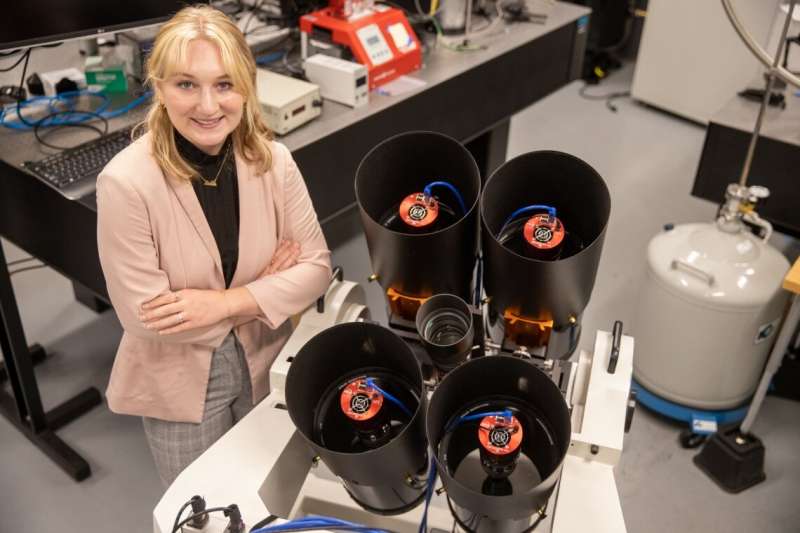As satellites crawl across the sky, they reflect light from the sun back down to Earth, especially during the first few hours after sunset and the first few hours before sunrise. As more companies launch networks of satellites into low-Earth orbit, a clear view of the night sky is becoming rarer. Astronomers, in particular, are trying to find ways to adapt, writes Mikayla Mace Kelley of the University of Arizona (U of A).
With that in mind, a team of U of A students and faculty has completed a comprehensive study to track and characterize the brightness of satellites, using a ground-based sensor they developed to measure satellites’ brightness, speed and paths through the sky. Their work could be helpful for astronomers, who — if notified of incoming bright satellites — could close the shutters of their telescope-mounted cameras to prevent light trails from tainting their long-exposure astronomical images.
The research team was led by professor of planetary sciences Vishnu Reddy, who co-leads — with professor of systems and industrial engineering Roberto Furfaro — the university’s Space Domain Awareness lab, which tracks and characterizes all kinds of objects orbiting Earth and the moon.
Grace Halferty, a senior graduating this summer with a bachelor’s degree in aerospace and mechanical engineering, is the lead author of the study, which is published in Monthly Notices of the Royal Astronomical Society. The study details how the team created a satellite-tracking device to measure the brightness and position of SpaceX Starlink satellites and compared those observations to government satellite-tracking data from the Space Track Catalog database.
“Until now, most photometric — or brightness — observations that were available were done by naked eye,” Halferty said. “This is one of the first comprehensive photometric studies out there to go through peer review. The satellites are challenging to track with traditional astronomical telescopes, because they are so bright and fast-moving, so we built what’s basically a small sensor with a camera lens ourselves because there was nothing off the shelf available.”
The team made 353 measurements of 61 satellites over two years and found that the position of Starlink satellites as recorded in the government’s Space Track Catalog only differed by an average of 0.3 arc seconds from the U of A calculations. An arc second on the sky is about the size of a dime held 4 kilometres away. The tiny difference is probably due to natural lag times in the government data, Reddy said. Because that data is based on estimated orbits calculated days earlier, rather than on real-time observations, positioning errors can build up.
This suggests that there is hope that astronomers can use this data to close the shutter of their telescopes in time amid the growing chaos in the skies above,” Reddy said.
Starlink is a large network of satellites, also called a mega constellation, operated by SpaceX with the goal of providing global internet coverage. SpaceX started launching Starlink satellites in 2019. Today, more than 2,700 Starlink satellites have launched — a fraction of the intended total of 42,000 satellites.
Other examples of satellite constellations include 31 GPS satellites and 75 iridium satellites for communication. Other entities have plans to launch more satellites into low and medium Earth orbit in the next few years. Amazon, for example, plans to launch 3,000 satellites, and the Chinese government plans to launch 13,000. These satellites will orbit no higher than 35,000 km above Earth.
The problem with satellites is that they require power harvested from solar panels, which can reflect sunlight at ground-based telescopes, and in turn, affect astronomical observations from telescopes around the world. About 30% of all telescope images will be affected by at least one satellite trail once the Starlink constellation is complete, said research team member Tanner Campbell, a graduate research assistant in the Department of Aerospace and Mechanical Engineering.
“As other constellations are added, the problem will only get worse for ground-based astronomical surveys,” he said.
These satellites are even more reflective right after launch, while they are still relatively low and tightly clustered before they spread throughout their orbit over time. They are often as bright as Saturn or Jupiter, two of the brightest objects in the night sky. As they manoeuvre into higher orbits, they become slightly fainter.
SpaceX has deployed a few different methods to darken its Starlink satellites. For example, VisorSat satellites rely on a shade to block additional sunlight, making them 1.6 times fainter. DarkSat satellites, on the other hand, rely on an anti-reflective coating that makes them 4.8 times fainter. However, DarkSats got too hot, so SpaceX moved away from that method. Since August 2021, all Starlink satellites are VisorSats.
“While these modifications are steps in the right direction, they also don’t dim the satellites enough for astronomical surveys,” said research team member Adam Battle, a graduate student studying planetary science.
In July, SpaceX announced new strategies. One involves mirrors that reflect sunlight away from Earth and another involves using darker building materials. Reddy’s team plans to study how effective these methods are at reducing sunlight reflection back to Earth.
While knowing exactly where satellites are is helpful to astronomers, the act of shutting the cameras adds overhead costs for telescopeoperations. Surveys become less efficient when astronomers have to close the shutter or throw away contaminated images. For example, a survey that would take five years to complete could take 10% to 20% more time if survey efficiency is down. Costs will continue to increase as more satellites are launched, Reddy said.
https://phys.org/news/2022-08-satellites-students-astronomers.html


